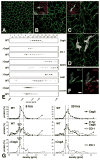Disruption of the epithelial apical-junctional complex by Helicobacter pylori CagA
- PMID: 12775840
- PMCID: PMC3369828
- DOI: 10.1126/science.1081919
Disruption of the epithelial apical-junctional complex by Helicobacter pylori CagA
Abstract
Helicobacter pylori translocates the protein CagA into gastric epithelial cells and has been linked to peptic ulcer disease and gastric carcinoma. We show that injected CagA associates with the epithelial tight-junction scaffolding protein ZO-1 and the transmembrane protein junctional adhesion molecule, causing an ectopic assembly of tight-junction components at sites of bacterial attachment, and altering the composition and function of the apical-junctional complex. Long-term CagA delivery to polarized epithelia caused a disruption of the epithelial barrier function and dysplastic alterations in epithelial cell morphology. CagA appears to target H. pylori to host cell intercellular junctions and to disrupt junction-mediated functions.
Figures




Comment in
-
Molecular hijacking and intracellular chaos.Gastroenterology. 2004 Feb;126(2):613-4; discussion 614-5. doi: 10.1053/j.gastro.2003.08.051. Gastroenterology. 2004. PMID: 14762802 No abstract available.
References
Publication types
MeSH terms
Substances
Grants and funding
LinkOut - more resources
Full Text Sources
Other Literature Sources
Miscellaneous

